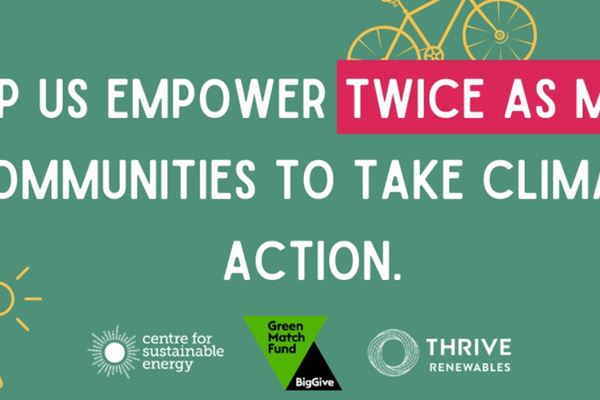Last week, the government published its widely anticipated energy security strategy and, while it was supposed to give us a clear roadmap for reducing our dependence on imported gas, it did little to alleviate the immediate fears of many people across the UK struggling with their energy bills.
The challenge is that changing the energy system takes time, so taking a long view is essential. It was positive to see that the strategy aligned with how we’re going to achieve net zero, recognising the important role renewables will play in ending our reliance on fossil fuels and lowering the cost of energy. In fact, the government stated that 95% of the country’s electricity could come from low-carbon sources by 2030 – five years ahead of its existing aim of decarbonising the grid by 2035. It largely focused on nuclear power and offshore wind, however, and missed obvious, shorter-term solutions such as improving energy efficiency and utilising onshore wind.
Below are some of our biggest takeaways from the strategy and what this means for increasing energy security, helping with fuel poverty and tackling the climate crisis.
SOLAR POWER
The government has stated that it will look to increase the UK’s current 14GW of solar capacity, with the potential to grow this up to 5 times by 2035. Alongside onshore wind, solar is one of the quickest and cheapest ways to generate clean power, but there were no concrete targets or details, other than the need to explore both large-scale projects and rooftop solar panels. Commercial rooftop solar arrays can help businesses to reduce energy bills and decrease their carbon footprint. We’ve been working with Olympus Power since 2020, building on our ‘direct wire’ approach where businesses benefit financially and environmentally from the electricity they generate on site.
In response to the strategy, Solar Energy UK stated that a five-fold increase in generation would help support 60,000 green jobs. However, to achieve this there has to be ‘significant investment in grid infrastructure and further reforms to planning to expedite new solar projects’.
ONSHORE WIND
Prior to the strategy, we supported RenewableUK (RUK) in its calls for a tangible target around onshore wind. According to RUK, doubling the UK’s capacity to 30GW by 2030 would reduce consumer bills by £16.3 billion, generate £45 billion of economic activity and create 27,000 full-time jobs in the UK. Analysis by Carbon Brief has also revealed that wind and solar generation is now six times cheaper than UK gas generation.
Despite claims to the contrary, wind turbines are popular with the public, much more so than nuclear. In fact, public attitudes data from BEIS has found that 80% are supportive of building new onshore wind capacity, compared to 37% with nuclear. It was therefore really disappointing to see the government miss a huge opportunity to unleash the power of onshore wind. Instead of supporting widespread acceleration through changes to planning regulations, the government has said that it will be consulting on how to develop partnerships with ‘a limited number of supportive communities who wish to host new onshore wind infrastructure in return for guaranteed lower energy bills’.
The problem with this is that the planning restrictions introduced under David Cameron in 2015 have made building new onshore wind almost impossible for communities in England because they have to show that the site is designated for onshore wind development and is stated so in the local plan. Research by Dr Rebecca Windemer, lecturer in environmental planning at the University of West England, found that new wind farms can’t be developed in 89% of local authorities in England. Given the very ambiguous wording shared in the strategy, it will be interesting to see how this consultation plays out and what changes they will be making to support those wanting to host onshore wind projects. Our work for the last 25 years has been helping people meaningfully connect with renewable energy and we will be doing everything we can to open up opportunities for communities looking to generate their own power from wind.
It's worth mentioning that it wasn’t all doom and gloom for onshore wind. The government did mention that it will look at arrangements to support the repowering of existing onshore wind sites, which we consider to be a crucial component in decarbonising the energy system. Again, quite how this unfolds is yet to be seen but repowering and life extension has the potential to generate much more power. We undertook the exercise at our Caton Moor wind farm, replacing ten old turbines with eight more modern, efficient machines. As a result, we were able to increase generation sevenfold to 47 million units of electricity per annum.
BATTERY STORAGE
The ramping up of renewables has knock-on effects for storage innovation, with the government stating that within the decade we will need to prioritise ‘hyper-flexibility in matching supply and demand so that minimal energy is wasted’. It claims that a more efficient, responsive system could bring costs down by up to £10 billion a year by 2050.
To enable this flexibility, the strategy also states that the government will ‘encourage all forms of flexibility with sufficient large-scale, long-duration electricity storage to balance the overall system by developing appropriate policy to enable investment’. Again, there is a lack of clear targets but it’s positive to see acknowledgement of battery storage and the role it plays in balancing out the variability of renewable sources such as wind and solar. In addition to the 5MW battery we built in 2021, we’re commencing construction of a 20 MW site at Feeder Road in Bristol, which will have the capacity to deliver 1.5 hours or 30MWh of electricity to the national and local grid. The benefit of smaller scale projects like this is that they can be developed relatively quickly and can work in tandem to operate as a single, distributed power plant.
It’s important to note that there were also positives around geothermal, offshore wind and floating wind, but the strategy was less of a detailed action plan and more of a list of woolly ‘ambitions’. We remain committed to informing these conversations as we move forwards.



